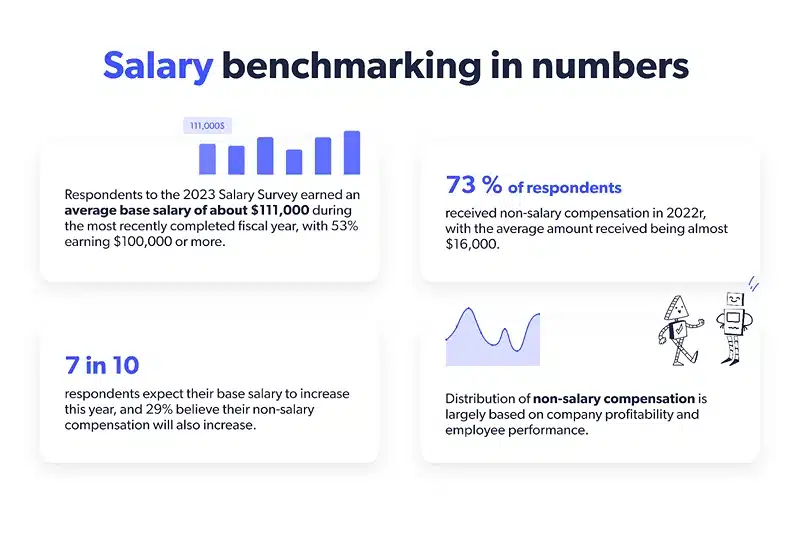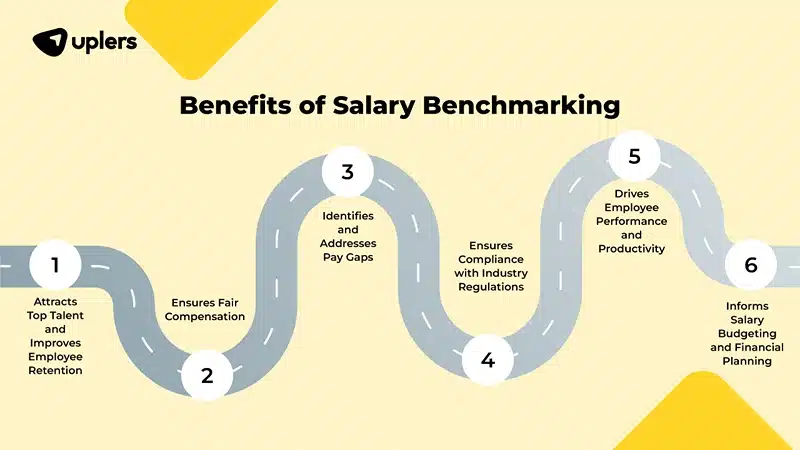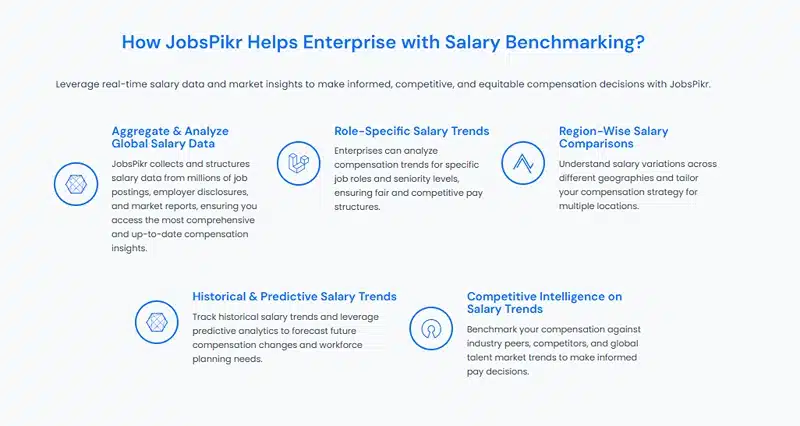
How Salary Data Shapes Smarter Salary Benchmarking Strategies

Image Source: HRForecast
When it comes to paying employees fairly and competitively, guesswork just doesn’t cut it anymore. Companies are starting to realize that their pay decisions must be grounded in reality, not just internal budgets or old market reports. That’s where salary data becomes a game changer.
Salary benchmarking is the process of comparing your internal pay ranges with what’s being offered in the wider job market. It helps ensure your compensation packages are in line with industry standards. But to do that well, you need access to current and reliable salary data.
Think of salary data as the foundation of any compensation strategy. Without it, you’re building your approach on shaky ground. With the right data, however, you can answer critical questions: Are we underpaying our engineers? Are our competitors offering more for the same role? Should we adjust our packages based on region or experience level?
What makes this even more complex is how quickly things can change. Job roles evolve, skills shift, and what was competitive six months ago might not hold up today. This is why real-time salary trends matter. They allow businesses to benchmark salaries based on the latest insights — not just annual surveys or historical averages.
Platforms like PromptCloud help gather and process massive volumes of web data, giving businesses access to real-time salary benchmarks. When paired with tools like JobsPikr, which offers labor market intelligence, HR teams gain a clearer view of not just how much to pay — but also when to adjust and why.
How Smart Salary Benchmarking Can Help You Keep Great People

Image Source: Uplers
Employees Know When They’re Underpaid
Let’s be real — people talk. Whether it’s on LinkedIn, Glassdoor, or Slack groups, salary info spreads fast. If your compensation isn’t aligned with the market, your team probably already knows it. And when employees realize they’re being paid less than peers elsewhere, that’s when retention becomes a problem.
Salary Benchmarking Isn’t Just for Hiring
Most companies think about salary benchmarking when they’re creating job offers. But it’s just as useful for keeping the people you already have. Benchmarking helps you spot pay discrepancies early and fix them before they turn into resignation letters.
Compensation Benchmarking Builds Trust
Fair pay doesn’t just help you hold onto people — it builds a sense of trust. When employees see that their company is paying attention to the market and adjusting accordingly, they feel respected. That kind of trust leads to higher engagement, better collaboration, and a stronger culture overall.
Outdated Salary Data Can Cost You Talent
Using stale salary reports is risky. In fields like tech, healthcare, and analytics, salaries can shift quickly due to demand. If your salary data is six months old, you might already be out of step with the market. That’s why up-to-date salary trends are essential for any retention strategy.
What Real-Time Salary Trends Actually Tell You (And Why They Matter)
Let’s say you’re about to post a job opening. You’ve got the title ready, the responsibilities listed, and a rough idea of what you think the salary should be. But then you pause — and ask yourself: Is this what people are really getting paid right now?
That one question can make or break your hiring effort.
This is where salary trends come in. Not just any trends — real, current, live-from-the-market salary data. Because the truth is, a lot can change in a short time. A sudden demand for a certain skill. A shift in remote work policies. An unexpected surge in hiring in a specific city. These things ripple through salaries almost overnight.
Now, if you’re basing your offer on a PDF from last year, you’re flying blind. But if you’re using tools that track salary movements in real time — like PromptCloud’s data engine or JobsPikr’s job market analytics — you’re suddenly not guessing anymore. You’re informed.
And here’s where it gets interesting: it’s not just about knowing what to pay. These trends can show you where the talent is moving, which roles are becoming harder to fill, and what kind of compensation is starting to raise eyebrows. Sometimes, you’ll even see things before your competitors do — and that can give you a serious edge.
So instead of asking “What should we pay?”, you start asking better questions:
- Should we be hiring in a different region?
- Do we need to rethink what this role really requires?
- Can we get ahead of a retention problem before it shows up in our exit interviews?
That’s the value of real-time salary data. It shifts you from reacting to anticipating. And that shift? It’s where smart salary benchmarking really begins.
What Compensation Benchmarking Looks Like in Practice

Image Source: Leapsome
It’s one thing to talk about salary benchmarking in theory. But what does it actually look like when a company does it well?
Let’s walk through it.
Say you’re a compensation analyst at a mid-sized healthcare tech firm. You’ve been asked to review pay bands for your data engineering team. They’re a mix of experienced hires and recent grads, and there’s a sense — whispered, not shouted — that a few team members might be underpaid.
You don’t start by looking inward. You start with the market.
Using a salary benchmarking tool like the one PromptCloud powers, you pull real-time salary data for similar roles in your industry. You filter by region, seniority, and job title. What you find surprises you: salaries in your region for mid-level engineers have jumped 12% over the last 9 months. A year ago, your pay scale was competitive. Now, not so much.
You dig a bit deeper. JobsPikr shows an uptick in hiring for similar roles at three fast-growing competitors nearby. That demand is pushing salaries up faster than your internal budget accounted for. You also notice something else — companies are starting to offer better perks and remote work flexibility along with pay bumps.
So now, your decision isn’t just “do we raise salaries?” It’s “how do we adjust our entire package to stay in the game?”
You take those findings to leadership. You back them up with clean data. Not guesses, not gut instincts — facts. And now, instead of reacting after your best engineer quits, you’ve made a move early. You’ve kept someone who might’ve left. You’ve strengthened your team without a crisis.
That’s what compensation benchmarking looks like when it works. It’s not just comparing numbers. It’s making better, smarter decisions with the kind of confidence that only good data can give you.
And when you repeat that process across departments — or make it part of your quarterly planning — you stop putting out fires. You start building a pay strategy that actually keeps up with your business.
PromptCloud’s Salary Data + JobsPikr’s Market Trends

Image Source: JobsPikr
PromptCloud Collects What’s Really Happening in the Market
PromptCloud pulls real-world salary data from live sources — not just surveys or user submissions. That means you get a look at what companies are actually offering, not just what they say they offer. This data gives HR teams and hiring managers a sharper edge when planning compensation.
JobsPikr Adds Labor Market Intelligence
JobsPikr complements salary benchmarking with hiring trend analysis. It shows you where demand is increasing, what industries are growing, and which roles are becoming harder to fill. When paired with PromptCloud’s salary data, it gives you a well-rounded view of both pay and market behavior.
Together, These Tools Support Smarter Workforce Planning
Combining salary data and market trends helps you do more than offer competitive pay. It helps you time your hires better, identify risk areas in your team, and create compensation plans that are future-ready. You stop making reactive decisions and start leading with strategy.
The Future of Salary Benchmarking and Workforce Planning
The way we think about compensation is changing — and fast. A few years ago, it might’ve been enough to check salary reports once a year and adjust things based on instinct or feedback. Today? That approach just doesn’t cut it.
The workforce is more informed than ever. Job seekers can compare salaries in seconds. Employees can see what others in their role are making with a few clicks. And with remote work expanding the talent pool, you’re not just competing with the company across town — you’re up against organizations across the globe.
This is exactly why salary benchmarking is no longer just an HR task. It’s a business strategy. One that blends real-time data, thoughtful planning, and a willingness to adapt.
The future belongs to companies that are proactive. That means using tools that don’t just show you what salaries were — but where they’re going. It means keeping an eye on salary trends, not just to stay competitive, but to anticipate shifts in demand. It also means using data to inform not only how you pay people, but how you invest in them, grow their roles, and build loyalty over time.
Tools like PromptCloud and JobsPikr are already pointing in that direction. They give you more than just numbers — they give you insight. And when you combine that insight with smart, people-first decision-making, you get more than just better pay structures. You get a stronger, more stable workforce.If you’re looking to build a smarter, more data-driven compensation strategy, PromptCloud can help. Schedule a quick demo to see how real-time salary data can make salary benchmarking and workforce planning a whole lot easier — and more accurate.


















